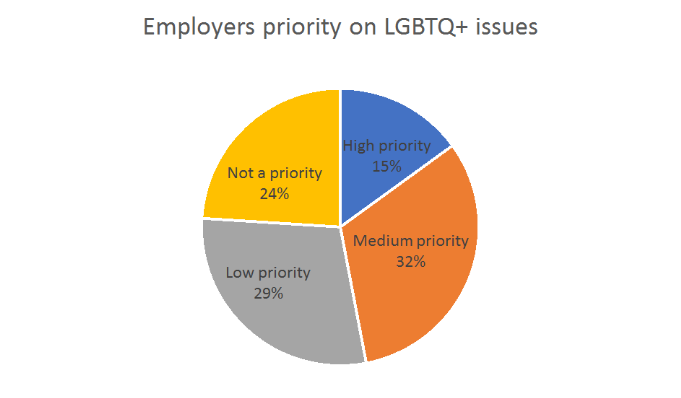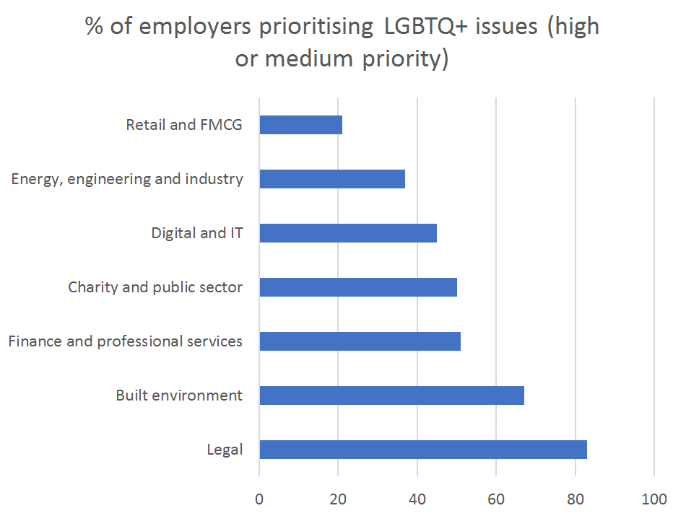ISE researcher Tristram Hooley dives into the data to raise a few questions and solutions about how employers are addressing diversity for lesbian, gay, bisexual, transgender, queer and questioning (LGBTQ+) people.
One of the things that I’ve been most struck by since I’ve been working with the Institute of Student Employers is the passion that exists for equality, diversity and inclusion.
Employers are generally really enthusiastic to make sure that the students that they are attracting and recruiting reflect the wider community and represent diverse perspectives and viewpoints. But, I’ve also noticed that issues of sexuality and gender identity often get less attention than class, ethnicity and sex.
Why aren’t we prioritizing LGBTQ+ issues?
When we ask employers about diversity issues in our surveys, they typically rank LGBTQ+ issues as a lower priority than all other diversity issues. Over half of employers rank LGBTQ+ issues as either not a priority or a low priority, while only 15% view it as a high priority. In contrast 68% of employers view gender as a high priority, 47% ethnicity and 45% social mobility.

This lack of priority is a bit concerning, particularly as the Office for National Statistics have found that the number of LGBTQ+ people is increasing. Recent statistics also suggest that young people (16-24) are almost twice as likely to identify as LGBTQ+ in comparison with older people.
Sectoral differences
When we dig further into these figures some clear patterns emerge in terms of sector, with some sectors (legal, built environment, finance and professional services) focusing on this issue, while others (retail and FMCG, energy, engineering and industry, digital and IT) much less likely to address these issues.

There may be all sorts of reasons for these sectoral differences. Some sectors may perceive that they have a problem and may be seeking to address this, while others may be ignoring it because they believe that they don’t have an issue.
It is clear that the rights of LGBTQ+ people has moved forward enormously over the last few decades, however, it can be very dangerous to conclude that there is no bias or homophobia in your industry.
Recent research published by the government highlights the fact that two-thirds of respondents had avoided holding their same-sex partner’s hand in public for fear of a negative reaction. Sad facts like this remind us that there is still a long way to go to achieve equality.
Do ask, do tell
Some employers may find this area challenging because LGBTQ+ issues have the potential to be much more invisible and unspoken than any of the other diversity strands. However, it is no longer acceptable to adopt the kind of ‘don’t ask, don’t tell’ policy that was once favoured by the US military. Inclusivity is about much more than tolerance or passive acceptance.
Employers that take LGBTQ+ diversity seriously will want to know how candidates and staff identify. Stonewall has produced a really useful guide to capturing data on sexual orientation and gender identity. Making sure that your firm understands who you are recruiting and some of the issues that they face is a very important first step.
Beyond this there are a huge array of ways that your firm can support LGBTQ+ diversity. Many of these will align with your other equality and diversity activities. Others might be more specific (see Stonewall’s Inclusive Workplaces section for further advice).
A recent article on Glassdoor showcases a host of different approaches that are being deployed by different companies and makes the point that being seen to be committed to LGBTQ+ equality can help to attract both gay and straight employees to want to work for you.
Prioritise LGBTQ+ diversity by…
- Ensuring that LGBTQ+ is explicitly addressed in your firm’s equality and diversity policy.
- Signaling that you are an LGBTQ+ friendly employer in recruitment materials and backing this up with employee testimonies.
- Having a clear and transparent approach for addressing bias, hate speech and bullying.
- Being aware of heteronormative practices (when you make an unconscious assumption that everyone is straight). These can be individual or institutional (e.g. looking at the language on your forms).
- Creating networking and resource groups for LGBTQ+ employees.
- Actively celebrating Pride Month within your firm.
- Being seen to be an LGBTQ+ friendly brand in your wider marketing, publicity and promotion. This might include things like supporting community campaigns and events.
The latest summer issue of The Student Employer explores this issue further, offering tips on how to create an inclusive environment – read ‘In and out at work’ p.34.


0 Comments